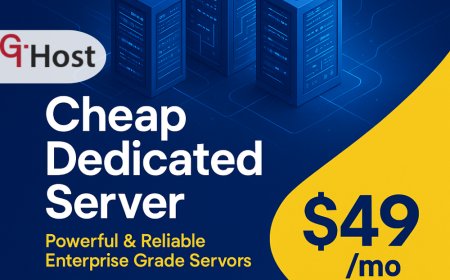How DevSecOps Ensures Robust Cloud Security for Modern Businesses?
Discover how DevSecOps ensures robust cloud security for modern businesses with continuous monitoring, automated compliance, and proactive threat defense.

As modern businesses increasingly move their operations and data to the cloud, ensuring security in this environment becomes absolutely critical. Cloud computing offers flexibility, scalability, and cost savings, but it also introduces new risks that traditional security methods struggle to manage effectively. To keep pace with todays fast-moving development cycles and complex cloud architectures, organizations are adopting DevSecOps a blend of development, security, and operations practices.
DevSecOps integrates security directly into the software development lifecycle, making it a continuous and shared responsibility. This blog explores how DevSecOps ensures robust cloud security for modern businesses, why its important, and the advantages it offers.
What Is DevSecOps?
The Basics Explained
DevSecOps stands for Development, Security, and Operations. Its an approach that integrates security measures into every stage of software development and deployment, instead of leaving security checks to the end. This helps catch vulnerabilities early, improve compliance, and maintain secure cloud environments.
Why DevSecOps Matters Today
Cloud applications and services update frequently, sometimes multiple times per day, to keep up with market demands. Traditional security methods that rely on slow manual testing cant keep up with this speed. DevSecOps brings automation, collaboration, and real-time monitoring to make security a continuous process.
The Need for Robust Cloud Security in Modern Business
Growing Cloud Adoption
Businesses are adopting cloud solutions for everything from hosting websites to managing sensitive customer data. While the cloud offers convenience and efficiency, it also expands the attack surface for cybercriminals.
Complex and Dynamic Environments
Cloud infrastructures are dynamic, with resources spinning up and down based on demand. This makes static security controls ineffective, as they cant adapt to constantly changing environments.
Increasing Cyber Threats
With more data and applications in the cloud, the number of attacks targeting cloud environments is rising. From data breaches and ransomware to insider threats, businesses need stronger, adaptive security measures.
How DevSecOps Ensures Robust Cloud Security
Integrating Security Early and Often
DevSecOps promotes the shift-left approach, meaning security practices begin early in development. Developers use automated tools to scan code for vulnerabilities as they write it, reducing the chance of introducing security flaws.
Continuous Security Testing and Monitoring
Security testing isnt a one-time event but happens continuously in DevSecOps. Automated tools check every new code change, configuration, and deployment for weaknesses. Real-time monitoring alerts teams to suspicious activity before it causes damage.
Infrastructure as Code (IaC) Security
In cloud environments, infrastructure is often managed using code to automate setup and scaling. DevSecOps enforces security checks on this code, ensuring configurations dont expose vulnerabilities like open ports or weak access controls.
Automated Compliance Enforcement
Compliance with industry regulations (like GDPR, HIPAA, or PCI DSS) is critical for many businesses. DevSecOps automates compliance checks within the development pipeline, helping businesses meet legal requirements without slowing down delivery.
Collaboration Across Teams
DevSecOps breaks down silos between development, operations, and security teams. Everyone shares responsibility for security, improving communication and faster response to threats or vulnerabilities.
Key Practices in DevSecOps for Strong Cloud Security
Secure Coding Practices
Developers are trained to write code that follows security best practices. Using secure coding standards and tools to identify common mistakes helps prevent vulnerabilities from entering the system.
Automated Vulnerability Scanning
Static Application Security Testing (SAST) and Dynamic Application Security Testing (DAST) tools automatically scan source code and running applications for security flaws with every build or deployment.
Role-Based Access Control (RBAC)
DevSecOps enforces the principle of least privilege by ensuring users and systems have only the access they need. This limits the potential damage if an account is compromised.
Incident Response Automation
When suspicious activity is detected, automated workflows can isolate affected systems, revoke access, or roll back deployments instantly to reduce risk.
Continuous Learning and Feedback
Feedback loops between teams help improve security practices over time. Developers receive reports on detected issues, allowing them to learn and improve code quality continuously.
Read more: Why DevSecOps Is Critical for Cloud Security Compliance?
Benefits of DevSecOps for Cloud Security
Faster Detection and Resolution of Security Issues
By integrating security into every step, vulnerabilities are found earlier and fixed faster, reducing exposure time.
Improved Security Posture
With constant monitoring, automated tests, and proactive policies, businesses build stronger defenses that adapt to emerging threats.
Lower Costs
Fixing issues early in development is cheaper than responding to breaches or extensive audits. Automation reduces manual work, saving resources.
Increased Business Agility
DevSecOps enables faster delivery of features and updates without sacrificing security, helping businesses respond quickly to market changes.
Enhanced Customer Trust
When customers know their data is protected by robust security practices, they are more confident in using your services, boosting reputation and loyalty.
Challenges and How to Overcome Them
Cultural Shift
Adopting DevSecOps requires a mindset change where security is a shared responsibility. Providing training and leadership support helps drive this culture.
Tool Complexity
Choosing and integrating the right tools can be overwhelming. Starting with core tools and expanding gradually reduces complexity.
Balancing Speed with Security
Pressure to deliver quickly can lead to shortcuts. Automating security checks ensures speed doesnt come at the cost of safety.
Conclusion
In a world where cloud computing is central to business operations, robust cloud security is a necessity, not an option. DevSecOps offers a comprehensive, proactive approach that integrates security into every phase of development and operations. This ensures that vulnerabilities are caught early, compliance is maintained effortlessly, and threats are detected and addressed in real time.
By fostering collaboration between teams and using automation to speed up testing and monitoring, DevSecOps helps modern businesses stay secure without sacrificing agility. Embracing DevSecOps practices is essential for building resilient cloud systems that protect your data, reputation, and customers. Partnering with an experienced on demand app development company can help you implement DevSecOps successfully, ensuring your cloud applications are safe, reliable, and ready for future growth.
FAQs
What is the main advantage of DevSecOps over traditional security methods?
DevSecOps integrates security throughout the development process, enabling faster detection and resolution of issues rather than leaving security as a final step.
How does DevSecOps improve compliance in cloud environments?
By automating compliance checks and embedding policies into CI/CD pipelines, DevSecOps ensures continuous adherence to industry regulations.
Can DevSecOps be applied to any cloud platform?
Yes, DevSecOps principles are platform-agnostic and can be implemented on AWS, Azure, Google Cloud, or hybrid environments.
Is DevSecOps only for large organizations?
No, businesses of all sizes can benefit from DevSecOps by adopting scalable automation and collaboration practices.
How does DevSecOps impact the speed of software delivery?
DevSecOps uses automation to integrate security checks without slowing down development, allowing faster and safer software releases.
































